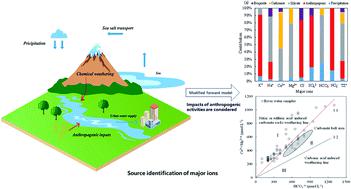当前位置:
X-MOL 学术
›
Environ. Sci.: Processes Impacts
›
论文详情
Our official English website, www.x-mol.net, welcomes your
feedback! (Note: you will need to create a separate account there.)
Quantifying the impacts of anthropogenic activity on chemical weathering based on source identification of hydrochemistry: the Liuxi river basin, southern China
Environmental Science: Processes & Impacts ( IF 4.3 ) Pub Date : 2020-11-12 , DOI: 10.1039/d0em00332h Zhigang Yang 1, 2, 3, 4 , Zuobing Liang 1, 2, 3, 4 , Lei Gao 1, 2, 3, 4 , Rui Li 1, 2, 3, 4 , Zhuowei Wang 4, 5, 6 , Aiping Zhu 4, 7, 8, 9 , Shaoheng Li 1, 2, 3, 4 , Zhenglan Xie 1, 2, 3, 4 , Jianyao Chen 1, 2, 3, 4 , Zhongjing Wang 4, 10, 11, 12, 13
Environmental Science: Processes & Impacts ( IF 4.3 ) Pub Date : 2020-11-12 , DOI: 10.1039/d0em00332h Zhigang Yang 1, 2, 3, 4 , Zuobing Liang 1, 2, 3, 4 , Lei Gao 1, 2, 3, 4 , Rui Li 1, 2, 3, 4 , Zhuowei Wang 4, 5, 6 , Aiping Zhu 4, 7, 8, 9 , Shaoheng Li 1, 2, 3, 4 , Zhenglan Xie 1, 2, 3, 4 , Jianyao Chen 1, 2, 3, 4 , Zhongjing Wang 4, 10, 11, 12, 13
Affiliation

|
The impact of anthropogenic activity on chemical weathering is still an open and significant topic that requires clarification to improve the understanding of watershed evolution. We analyzed river water and rainwater samples to characterize the variation in hydrochemical characteristics and influencing factors. Samples were taken from the Liuxi River Basin (LRB), the only local drinking water supply for Guangzhou, and we studied geochemical parameters, major ions, and Si concentrations. Moreover, elemental ratios of end-members were determined and a modified-forward model was constructed to identify ion sources and estimate the chemical weathering rate (CWR) and anthropogenic input rate (AIR). Finally, we quantified the impacts of anthropogenic activity on the chemical weathering process. The results showed that the dominant hydrochemical type of river water was identified as HCO3–Ca, and rock weathering was the main contributor to river Na+, Mg2+, Ca2+ and HCO3−, whereas anthropogenic activity contributed the most to K+, Cl−, SO42−, and NO3−. The relatively high silicate weathering rate (SWR) (17.8–18.4 t per km2 per year) and AIR (37.8–60.3 t per km2 per year) were mainly attributed to erosion by nitric and sulfuric acid. The contribution rate of these acids to CWR could be regarded as a proxy quantifying the impact of anthropogenic activity on the chemical weathering process. This accounted for approximately 30% of the total SWR in the LRB. Our results demonstrate the effectiveness of hydrochemical source identification for quantifying the impacts of anthropogenic activity on chemical weathering.
更新日期:2020-12-09











































 京公网安备 11010802027423号
京公网安备 11010802027423号